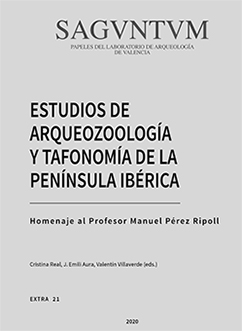Quaternary cliff-dwelling bovids (Capra, Rubicapra, Hemitragus, Ovis): site's typology and taphonomic remarks
 Resumen
Resumen
In Europe, Quaternary karstic deposits yield commonly remains of Caprinae (Capra, Rupicapra, Hemitragus, Ovis). A database is elaborated on rich-caprine sites, especially from France and Spain. Based on data dealing with topography and morphology of karstic settings (sinkholes, horizontal galleries), and quantification of faunal remains (NISP, skeletal elements) as well as taphonomic observations (age classes, sex-ratio, carnivore activity), a typology of caprine sites is proposed. Questions are raised about deposit formation and agents of such accumulations. Preliminary data suggest the importance of medium-sized felids (leopard) and canids (wolf) as main predators of cliff-dwelling bovids and/or canids as a systematic secondary bone modifier. Other types of sites concern natural traps and anthropogenic bone accumulations (rock shelters and caves) mainly dated of Late Paleolithic.
 Descargas
Descargas
Descargas
Publicado
Cómo citar
-
Resumen283
-
PDF 227
Número
Sección
Licencia

Este obra está bajo una licencia de Creative Commons Reconocimiento-NoComercial-SinObraDerivada 4.0 Internacional.
Con la publicación impresa de los trabajos, los/as autores/as aceptan que el Departament de Prehistòria, Arqueologia i Història Antiga de la Universitat de València pueda permitir la difusión y el libre acceso a través de las direcciones electrónicas y enlaces del editor/a.
El contenido de los trabajos es responsabilidad de los/as autores firmantes y no expresa la posición ni la opinión del Consejo de Redacción.
Las obras que se publican en esta revista están sujetas a los siguientes términos:
1. La revista conserva los derechos patrimoniales (copyright) de las obras publicadas, y favorece y permite la reutilización de las mismas bajo la licencia indicada en el punto 2.
2. Las obras se publican en la edición electrónica de la revista bajo una licencia Creative Commons Reconocimiento-NoComercial-SinObraDerivada 3.0 España (texto legal). Se pueden copiar, usar, difundir, transmitir y exponer públicamente, siempre que se cite la autoría, la url, y la revista, y no se usen para fines comerciales.
3. Los/as autores/as están de acuerdo con la licencia de uso utilizada por la revista, con las condiciones de auto-archivo y con la política de acceso abierto.
4. En caso de reutilización de las obras publicadas debe mencionarse la existencia y especificaciones de la licencia de uso además de mencionar la autoría y fuente original de su publicación.



